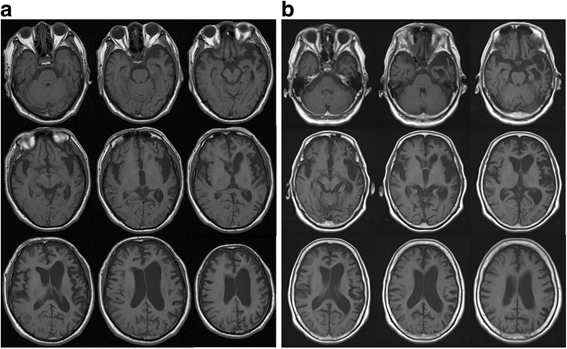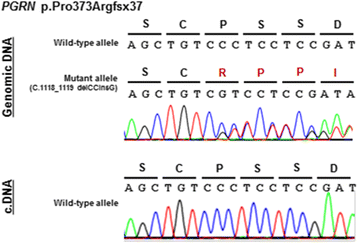A novel frameshift GRN mutation results in frontotemporal lobar degeneration with a distinct clinical phenotype in two siblings: case report and literature review
- PMID: 28915852
- PMCID: PMC5603021
- DOI: 10.1186/s12883-017-0959-2
A novel frameshift GRN mutation results in frontotemporal lobar degeneration with a distinct clinical phenotype in two siblings: case report and literature review
Abstract
Background: Progranulin gene (GRN) mutations are major causes of frontotemporal lobar degeneration. To date, 68 pathogenic GRN mutations have been identified. However, very few of these mutations have been reported in Asians. Moreover, some GRN mutations manifest with familial phenotypic heterogeneity. Here, we present a novel GRN mutation resulting in frontotemporal lobar degeneration with a distinct clinical phenotype, and we review reports of GRN mutations associated with familial phenotypic heterogeneity.
Case presentation: We describe the case of a 74-year-old woman with left frontotemporal lobe atrophy who presented with progressive anarthria and non-fluent aphasia. Her brother had been diagnosed with corticobasal syndrome (CBS) with right-hand limb-kinetic apraxia, aphasia, and a similar pattern of brain atrophy. Laboratory blood examinations did not reveal abnormalities that could have caused cognitive dysfunction. In the cerebrospinal fluid, cell counts and protein concentrations were within normal ranges, and concentrations of tau protein and phosphorylated tau protein were also normal. Since similar familial cases due to mutation of GRN and microtubule-associated protein tau gene (MAPT) were reported, we performed genetic analysis. No pathological mutations of MAPT were identified, but we identified a novel GRN frameshift mutation (c.1118_1119delCCinsG: p.Pro373ArgX37) that resulted in progranulin haploinsufficiency.
Conclusion: This is the first report of a GRN mutation associated with familial phenotypic heterogeneity in Japan. Literature review of GRN mutations associated with familial phenotypic heterogeneity revealed no tendency of mutation sites. The role of progranulin has been reported in this and other neurodegenerative diseases, and the analysis of GRN mutations may lead to the discovery of a new therapeutic target.
Keywords: Case report; Corticobasal syndrome; Frontotemporal lobar degeneration; Phenotypic heterogeneity; Primary progressive aphasia; Progranulin.
Conflict of interest statement
Ethics approval and consent to participate
The authors declare that ethics approval was not required for this case report.
Consent for publication
Written informed consents for the patient and her brother were obtained from the patient’s husband for publication of this Case Report and any accompanying images. A copy of the written consent is available for review by the Editor of this journal.
Competing interests
The authors declare that they have no competing interests.
Publisher’s Note
Springer Nature remains neutral with regard to jurisdictional claims in published maps and institutional affiliations.
Figures


References
Publication types
MeSH terms
Substances
LinkOut - more resources
Full Text Sources
Other Literature Sources
Miscellaneous

